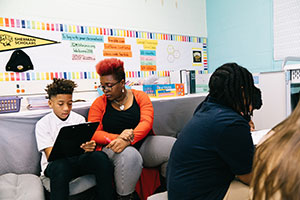New community engagement project aids critical need for literacy tutors in Baltimore

Loyola has had various partnerships for the past 11 years with many of the schools within the York Road corridor and the schools have long been sites for Loyola’s Center for Community, Service, and Justice (CCSJ) volunteers to offer tutoring; however, with the COVID-19 pandemic and its effects on student learning, the need for highly trained literacy tutors became even more critical. That’s why Loyola’s Community Engaged Literacy Project (CELP) was developed.
Inspired by Loyola’s commitment to academic excellence and the Jesuit mission of social justice, Literacy Co-Director, Kristina Collins, saw an opportunity where her graduate students could serve the community through providing free educational resources in both tutoring and training.
Loyola’s Community Engaged Literacy Project (CELP) is a collaborative endeavor between K-8 schools along the York Road Corridor, Loyola’s School of Education, Loyola’s Center for Community, Service, and Justice (CCSJ), and Loyola’s Clinical Centers (LCC) and was created to address the critical need for highly trained literacy tutors as a result of the COVID-19 pandemic and its effects on student learning.
Initial discussions and planning between all stakeholders for the CELP began in November 2020. Kelly Ricardi, a current graduate student in Loyola’s M.Ed. in Literacy Education, Reading Specialist program, was hired in February 2021 to lead the project.
Ricardi is originally from Ellington Conn. and has been teaching since earning her bachelor’s in elementary education from Central Connecticut State University in 2017. “I have worked everywhere from first to fifth grades, and I have found something I loved in every single grade,” said Ricardi.
Ricardi has done the majority of her teaching in Maryland and says that hearing about the reputation of Loyola from colleagues is what lead her to find Loyola’s literacy graduate program. “I feel like this project has been an extension of everything I have learned in my reading specialist certification program. This program is almost mimicking and preparing me on a course-to-course basis of what I am able to include in my work on the CELP.”
Ricardi immediately began to take the vision of the CELP and make it into a reality.
“Kelly has been an invaluable resource to the development and implementation of the
CELP,” said Collins.
Ricardi’s initial work included applying for grants to secure seed funds for the project
and creating instructional content to help tutors learn the fundamentals of literacy
tutoring and assessment. Ricardi leveraged her knowledge and experience as a public
school teacher and graduate student to ensure tutors who undergo the CELP training
are confident and effective tutors in the community.
Govans Elementary is the pilot school for the project. Tutors are working with the principal and reading specialists at the school and receiving feedback and input from many experts in the field. “Govans has been such a big stakeholder and influence in how we have built this program and they have provided feedback along the way,” said Ricardi.
Total impact and reach will be critical success metrics for the CELP. Tutors have been charged with being involved in the community, reaching out to as many resources as possible, and meeting with as many students as possible. They are thinking through how they can hold everyone accountable and how to measure efficacy, while using their expertise to ultimately make a lasting impact on the students. Data collection will take place in the spring of 2022 to measure the efficacy of the program—including the impact the tutors are having on the students and community as well as the impact of the CELP on the tutors’ education and development.
Parents and teachers will have access to the same information that the tutors will have on students in the program, which will influence class placements in school, interventions that are put in place in schools, and how the students are moved throughout the school. “It’s all about the kids. We want to see the impact it has on the kids and the impact it has on the community at large,” said Ricardi.
“I don’t think there’s a limitation of where this could go. I don’t think this program will look the same on a year-to-year basis because we are constantly updating, changing, and modifying based on all the feedback we are getting,” explained Ricardi. “We don’t want to be just an afterschool program. We are really looking to be a part of that vision, that dream, and the success of the schools.”